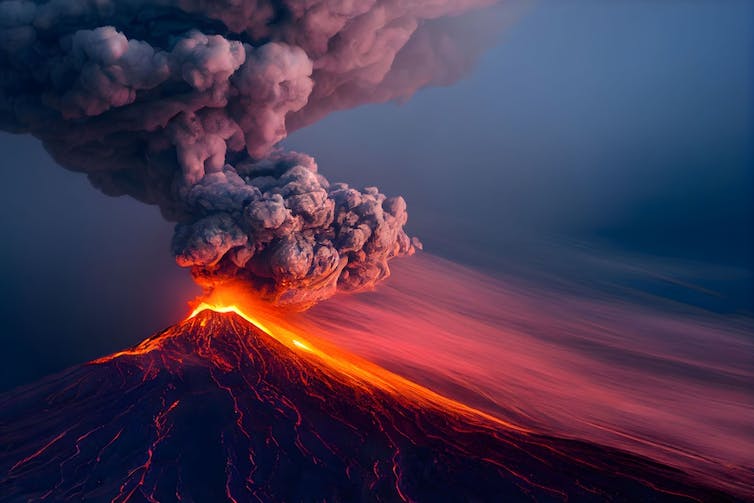Ediacaran life as imagined by scientists within the Eighties. Ryan Somma/Wikimedia, CC BY-SA
Some half a billion years in the past, life on Earth went via an enormous transformation. In what known as the Ediacaran interval, after billions of years of single-celled organisms, massive multicellular organisms emerged within the fossil document.
These traces of the oldest complicated ecosystems have been present in solely a handful of areas all over the world. The fossils have been made by soft-bodied creatures lined by sand, creating impressions of their squashed stays imprinted into rock.
Evidence of those creatures was first discovered within the Ediacara Hills, in South Australia’s Flinders Ranges. The discovery was pivotal in defining the Ediacaran interval: a time in Earth’s previous characterised by a selected layer of rock which symbolises a major change in historical past.
What was taking place elsewhere presently? Similar-looking fossils have been present in a disused quarry in a farmer’s subject at Llangynog in Wales, however till now their exact age was unknown.
In a brand new examine revealed in Journal of the Geological Society, we’ve dated these Welsh remnants of historical marine life. Now, we are able to affirm they have been close to contemporaries of the well-known South Australian fossils.
A bookmark for rocks
How do geologists work out the age of fossils? Understanding the age of fossils is extraordinarily helpful for correlation and understanding how organic communities advanced.
Luckily, not less than for us right now, an environmental disaster loomed within the shallow sea the place these Welsh organisms lived.
Volcanic explosions threw mineral particles over the encompassing panorama and polluted the environment with poisonous gases.
The billowing crimson sizzling clouds created ash layers. These ash layers comprise mineral grains which can be isotopically datable, performing like miniature stopwatches that document the time elapsed since they crystallised in a volcano. Hence, volcanic ash acts very like a bookmark in a sequence of rocks, monitoring the second of eruption.

Volcanic eruptions produce layers of ash that can be utilized as ‘bookmarks’ within the geological document.
CGS Graphics
A clock for rocks
A clock tick-tocks each second, however how can we measure time when every tick takes 1,000,000 years? We use a mineral referred to as zircon.
Trapped inside zircon is a few uranium that undergoes nuclear decay to steer over tens of millions of years. Scientists know the speed at which this variation happens, so by analysing the composition of the crystal we are able to use the zircon as a geological clock.
The extra exactly we measure the quantity of uranium and lead, the extra exact the clock. By rigorously dissolving, heating and analysing zircon, we’ve dated the rocks in Wales to 565 million years (plus or minus 0.1%). That is a exact loss of life certificates for the fossils.
Read extra:
Scientists cannot agree on when the primary animals advanced – our analysis hopes to finish the talk
It’s life, however not as we all know it
Evidence from Ediacaran fossils implies that after 4 billion years of oceans containing single-celled microbes, all of the sudden – in geological phrases not less than – the seas teemed with new complicated life. Ediacaran life is odd, with unusual soft-bodied kinds whose interplay with the atmosphere is unclear.
Were the creatures stationary, or did they transfer round and eat one another? In some methods these creatures can be surprisingly acquainted, but in one other approach, weird.
Some appeared fern-like, others like cabbages, and but others have been just like fashionable sea pens, resembling fats, old style writing quills.
Nevertheless, fossils from this time protect the earliest proof for large-scale multicellular organisms, together with the primary animals.

The rolling countryside of mid-south Wales – hidden away in these hills is proof of historical life.
Parkerspics
A tropical paradise?
Half a billion years in the past, Wales was not inexperienced and sheep lined and appeared far more like a barren volcanic island. The Llangynog fossils are fascinating as a result of they document a shallow marine ecosystem.
In distinction, different well-known fossil websites like Charnwood Forest within the United Kingdom and Mistaken Point, Canada document deep-marine situations.

Aspidella, one of many strange fossils of Llangynog, Wales.
Anthony Clarke
In the shallow waters of the chain of tropical volcanic islands that’s now Wales, a creature referred to as Aspidella terranovica felt the heat of daylight and the sway of the tides 565 million years in the past. This fossil is uncommon and worthwhile as a result of it exhibits proof of motion.
Alongside Aspidella, different disc-like organisms are preserved; these may symbolize the anchor for fern-shaped filter feeders.
Hidden away in an unassuming quarry in Wales are the remnants of a various shallow marine ecosystem containing a few of Britain’s oldest fossils, which we’ve proved have cousins of an analogous age in Australia. This time in Earth’s historical past was simply after a world glaciation so extreme and widespread that some researchers contemplate your complete planet froze right into a “snowball”.
The Ediacaran fossils present this thaw-out heralded evolutionary change, demonstrating a profound hyperlink between our planet’s geological processes and its organic cargo.
Read extra:
Friday essay: the silence of Ediacara, the shadow of uranium
![]()
Chris Kirkland receives funding from the Australian Research Council and varied state authorities organisations inside Australia.
Anthony Clarke receives funding from the Australian Research Council.
